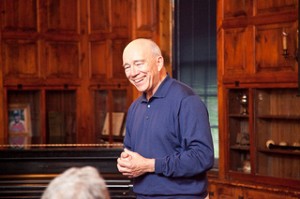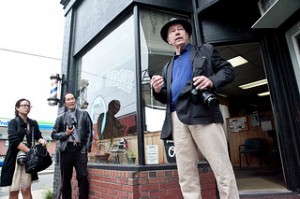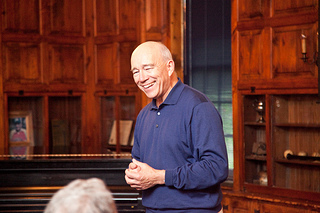“Something is wrong with this picture,” Sam Abell said to his audience on May 9, during the final Photographers’ Lecture Series of the 2012-11 season.
 Projected on the screen in the darkened Dodge Room was a photograph of two coffee cups on a tray and a glass of water. What was wrong? The audience strained to see.
Projected on the screen in the darkened Dodge Room was a photograph of two coffee cups on a tray and a glass of water. What was wrong? The audience strained to see.
Then the next slide appeared. Abell had turned the handle of a coffee mug, ever so slightly, to create a sliver of space between it and the shadow cast by the water.
Such small details have obsessed Abell throughout his long and illustrious career as a documentary photographer and on in-depth projects for National Geographic. As he noted in his artist’s statement, Abell “explores ways in which places can be purely recorded, with images simultaneously shaped by the photographer’s imagination.”
Pure photography is not about equipment, Abell explained, but about composing a picture in layers—starting with the horizon and moving through all of the details of setting, expression, and gesture.
“Life takes pictures away from you, it doesn’t deliver them,” Abell said. “It’s never the camera that made the picture. Photography is about the scene.”
Abell learned this lesson of micro-composition—giving attention to even the smallest particulars in the frame—early on from his father, who ran a photography club. He perfected the technique during a career of visiting regions near and far in search of the perfect shot.
“The picture you took was the picture you showed. The picture you showed was the picture your career depended on,” Abell explained to students during an afternoon class. “That is photography to me.”
Such patient attention to detail was one reason Abell’s career with National Geographic lasted so long. It was also why his career was fruitful enough to produce two of the magazine’s 50 greatest photographs ever made.
“There’s a way to bring the world under your control as a documentary photographer and it has nothing to do with Photoshop. It has to do with pure scene,” he told Advanced Photography students.
During his afternoon at Williston Northampton, Abell led the class to the streets in search of moments to micro-compose. But first, he lifted a camera to his eye and composed a few shots of one of the students, sitting at the table.
“Be a photographer of your time,” Abell said, clicking the shutter and examining the results. “It’s not great, but it’s good. It’s good because it’s honest.”


